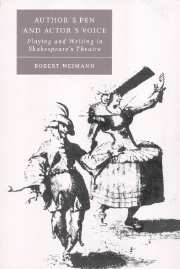Book contents
- Frontmatter
- Contents
- Preface
- Introduction: conjunctures and concepts
- 1 Performance and authority in Hamlet (1603)
- 2 A new agenda for authority
- 3 Pen and voice: versions of doubleness
- 4 Playing with a difference
- 5 Histories in Elizabethan performance
- 6 Hamlet and the purposes of playing
- 7 Space (in)dividable: locus and platea revisited
- 8 Shakespeare's endings: commodious thresholds
- Afterword: thresholds forever after
- Notes
- List of works cited
- Index
7 - Space (in)dividable: locus and platea revisited
Published online by Cambridge University Press: 22 September 2009
- Frontmatter
- Contents
- Preface
- Introduction: conjunctures and concepts
- 1 Performance and authority in Hamlet (1603)
- 2 A new agenda for authority
- 3 Pen and voice: versions of doubleness
- 4 Playing with a difference
- 5 Histories in Elizabethan performance
- 6 Hamlet and the purposes of playing
- 7 Space (in)dividable: locus and platea revisited
- 8 Shakespeare's endings: commodious thresholds
- Afterword: thresholds forever after
- Notes
- List of works cited
- Index
Summary
The Prologue and Chorus to Henry V had confidently asserted the theatre's ability to “digest” the “distance” in space between the absent imaginary landscape represented in the written text and the material site of its performance by visible, audible actors in front of living audiences. But the two different modes of cultural production, writing and playing, implicated not only nonidentical premises of articulation and response; they were partially at least predicated on differing concepts and conventions of space and its uses in and for entertainment. In fact, the nonidentity between them was contiguous with the difference between the newly expanding space in (imaginary) representation and the recently institutionalized, material space of its performance.
On the Elizabethan stage the difference between the imaginary landscape inscribed in the story and the physical, tangible site of its production was of particular, perhaps unique, consequence. Since there was both continuity and discontinuity between these two types of space, the drama in production, drawing on both the products of the pen and the articulation of voices and bodies, could through their interactions constitute at best an ‘indifferent boundary’ between them. In fact, the boundary between the inscribed matter and the performing agency of theatrical representations appears altogether fleeting; no matter how deep (or how deeply submerged) the cultural difference between them was, it never constituted a rigid division, let alone a binary opposition in either the semiotics or the semantics of theatrical space.
- Type
- Chapter
- Information
- Author's Pen and Actor's VoicePlaying and Writing in Shakespeare's Theatre, pp. 180 - 215Publisher: Cambridge University PressPrint publication year: 2000



